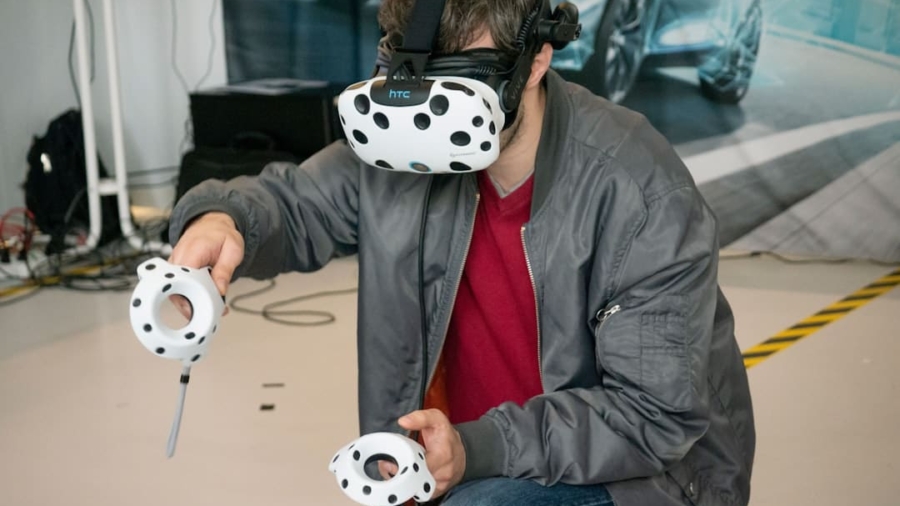Augmented Reality (AR) and Virtual Reality (VR) are rapidly transforming various industries, and architecture is no exception. These technologies offer innovative ways to visualize and interact with architectural designs, particularly in the realm of sustainability. As the world grapples with climate change and resource depletion, architects are increasingly tasked with creating buildings that not only meet aesthetic and functional needs but also minimize environmental impact.
AR and VR provide powerful tools that can enhance the design process, allowing architects to simulate real-world conditions, assess energy efficiency, and engage stakeholders in a more immersive manner. The integration of AR and VR into sustainable architecture design is not merely a trend; it represents a paradigm shift in how architects conceptualize and execute their projects. By leveraging these technologies, architects can create more informed designs that prioritize sustainability from the outset.
For instance, AR can overlay digital information onto physical spaces, enabling architects to visualize how a building will interact with its environment. Meanwhile, VR can transport clients and stakeholders into fully realized 3D models of proposed designs, allowing for a deeper understanding of spatial relationships and environmental impacts. This article delves into the myriad benefits of AR and VR in sustainable architecture, showcasing their potential to revolutionize the field.
Key Takeaways
- AR and VR technology are revolutionizing sustainable architecture design by providing immersive and interactive experiences for architects, designers, and clients.
- The use of AR and VR in sustainable architecture design offers benefits such as improved visualization, enhanced client engagement, reduced costs, and faster decision-making processes.
- Case studies of successful sustainable architecture projects using AR and VR demonstrate how these technologies have been instrumental in creating innovative and environmentally friendly designs.
- AR and VR play a crucial role in enhancing energy efficiency in building design by allowing architects to simulate and analyze various energy-saving strategies and technologies.
- The use of AR and VR improves collaboration and communication in sustainable architecture by enabling real-time feedback, virtual walkthroughs, and seamless interaction among project stakeholders.
The Benefits of Using AR and VR in Sustainable Architecture Design
Enhanced Visualization with AR
In contrast, AR enables architects to superimpose digital models onto real-world sites, providing a contextually rich view that highlights potential challenges and opportunities for sustainability. For instance, an architect can use AR to demonstrate how a building’s orientation will affect natural light intake or how landscaping choices can influence energy consumption.
Immersive Experience with VR
VR offers an immersive experience that significantly enhances stakeholder engagement. By stepping into a virtual model of a building, clients can experience the space as if they were physically present, allowing them to grasp the design’s nuances more effectively. This immersive experience can lead to more informed feedback and collaboration, ultimately resulting in designs that better meet sustainability goals.
This collaborative approach enables architects to create buildings that not only minimize environmental impact but also meet the needs of their occupants.
Case Studies of Successful Sustainable Architecture Projects Using AR and VR
Several pioneering projects have successfully integrated AR and VR into their sustainable architecture designs, showcasing the practical applications of these technologies. One notable example is the Bosco Verticale (Vertical Forest) in Milan, Italy. This residential complex features two towers adorned with over 9,000 trees and 20,000 plants.
The architects utilized VR simulations during the design phase to visualize how the greenery would interact with the building’s structure and surrounding environment. By simulating various growth scenarios, they were able to optimize plant placement for maximum energy efficiency and aesthetic appeal. Another compelling case study is the Eden Project in Cornwall, England, which consists of multiple geodesic domes housing diverse ecosystems.
The architects employed AR technology to visualize the complex’s integration with the surrounding landscape. By overlaying digital models onto physical site conditions, they could assess how the project would impact local biodiversity and water management systems. This approach not only informed design decisions but also engaged local communities in discussions about sustainability and environmental stewardship.
The Role of AR and VR in Enhancing Energy Efficiency in Building Design
Energy efficiency is a cornerstone of sustainable architecture, and AR and VR play crucial roles in optimizing building performance. Through these technologies, architects can conduct energy simulations that account for various factors such as orientation, materials, and climate conditions. For instance, using VR, architects can simulate how different building materials will respond to temperature fluctuations throughout the year.
This allows them to select materials that enhance thermal performance while minimizing energy consumption. Additionally, AR can assist in real-time energy monitoring during the construction phase. By overlaying digital data onto physical structures, construction teams can identify areas where energy efficiency measures may be lacking or where adjustments are needed to meet sustainability targets.
For example, if an AR application reveals that insulation is improperly installed in certain areas, teams can address these issues before they become costly problems. This proactive approach not only enhances energy efficiency but also contributes to the overall success of sustainable architecture projects.
How AR and VR Improve Collaboration and Communication in Sustainable Architecture
Collaboration is essential in sustainable architecture design, as it often involves multiple stakeholders with varying expertise and interests. AR and VR facilitate this collaboration by providing shared platforms for visualization and discussion. In traditional settings, communication can be hindered by misunderstandings arising from 2D drawings or technical jargon.
However, with AR and VR, all parties can engage with a common visual language that transcends disciplinary boundaries. For instance, during design charrettes or stakeholder meetings, architects can use VR headsets to immerse participants in a virtual model of the project. This shared experience fosters open dialogue about design choices and sustainability strategies.
Participants can explore different aspects of the design together, providing immediate feedback on elements such as layout, materials, and environmental impact. This collaborative approach not only enhances communication but also cultivates a sense of ownership among stakeholders, leading to more successful outcomes.
Overcoming Challenges and Limitations of AR and VR in Sustainable Architecture Design
Despite the numerous benefits of AR and VR in sustainable architecture design, several challenges must be addressed for these technologies to reach their full potential. One significant limitation is the high cost associated with developing and implementing AR and VR solutions. While prices have decreased over time, creating high-quality immersive experiences still requires substantial investment in software development and hardware acquisition.
Smaller firms may find it challenging to allocate resources for these technologies without compromising other aspects of their business. Another challenge lies in the need for training and expertise in using AR and VR tools effectively. Architects and designers must be proficient in navigating these technologies to maximize their benefits.
This necessitates ongoing education and professional development opportunities within the industry. Additionally, there may be resistance from some stakeholders who are unfamiliar with these technologies or skeptical about their effectiveness. Overcoming these barriers requires clear communication about the advantages of AR and VR in enhancing sustainable design practices.
The Future of AR and VR in Sustainable Architecture Design
Looking ahead, the future of AR and VR in sustainable architecture design appears promising as advancements continue to emerge at a rapid pace. As technology evolves, we can expect more sophisticated tools that integrate artificial intelligence (AI) with AR and VR capabilities. For example, AI algorithms could analyze vast amounts of data related to energy consumption patterns or environmental impacts, providing architects with actionable insights during the design process.
Furthermore, as sustainability becomes an increasingly pressing global concern, regulatory bodies may begin to mandate the use of AR and VR technologies in architectural practices. This could lead to widespread adoption across the industry as firms seek to comply with new standards aimed at reducing carbon footprints and promoting environmentally responsible design. Additionally, as public awareness of sustainability issues grows, clients may demand more transparency regarding how their projects align with sustainable practices—an area where AR and VR can provide valuable insights.
The Impact of AR and VR on the Future of Sustainable Architecture
The integration of Augmented Reality (AR) and Virtual Reality (VR) into sustainable architecture design represents a significant advancement in how architects approach their work. These technologies not only enhance visualization but also improve collaboration among stakeholders while promoting energy efficiency throughout the design process. As demonstrated through various case studies, successful projects have harnessed AR and VR to create innovative solutions that prioritize sustainability.
While challenges remain regarding cost and training, the potential benefits far outweigh these limitations. As technology continues to evolve and become more accessible, we can anticipate a future where AR and VR play an integral role in shaping sustainable architecture practices worldwide. The impact of these technologies will likely extend beyond individual projects; they may redefine industry standards for sustainability while fostering a culture of innovation within architectural firms.
Ultimately, AR and VR hold the promise of transforming not just how buildings are designed but also how they contribute to a more sustainable future for our planet.
In a related article, Discover the Best Software for Logo Design Today, the importance of utilizing the right tools for creating visually appealing and impactful logos is discussed. Just as AR and VR technology are revolutionizing sustainable architecture design, having access to the best software for logo design can greatly enhance the branding and marketing efforts of businesses. By leveraging cutting-edge software, designers can create logos that effectively communicate a company’s values and identity to its target audience.
FAQs
What is AR and VR in the context of sustainable architecture design?
AR (Augmented Reality) and VR (Virtual Reality) are technologies that allow architects and designers to create immersive and interactive experiences for visualizing and designing sustainable architecture. AR overlays digital information onto the real world, while VR creates a completely immersive digital environment.
How do AR and VR contribute to sustainable architecture design?
AR and VR allow architects and designers to visualize and simulate sustainable design elements such as energy-efficient building materials, natural lighting, and green spaces. This helps in making informed decisions about sustainable design features and their impact on the environment.
What are the benefits of using AR and VR in sustainable architecture design?
The benefits of using AR and VR in sustainable architecture design include improved visualization of sustainable design elements, enhanced collaboration among project stakeholders, reduced material waste through virtual prototyping, and the ability to test and optimize sustainable design solutions before construction.
How do AR and VR help in communicating sustainable design concepts to clients and stakeholders?
AR and VR provide a more immersive and interactive way to showcase sustainable design concepts to clients and stakeholders. This helps in effectively communicating the environmental benefits and the overall vision of sustainable architecture projects.
Are there any challenges in using AR and VR for sustainable architecture design?
Challenges in using AR and VR for sustainable architecture design include the initial cost of implementing the technology, the need for specialized skills and training, and the potential for technical limitations in creating accurate simulations of sustainable design elements.



